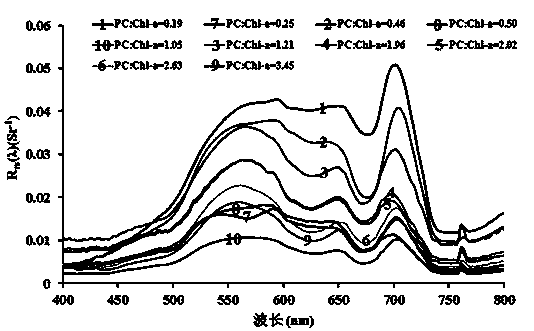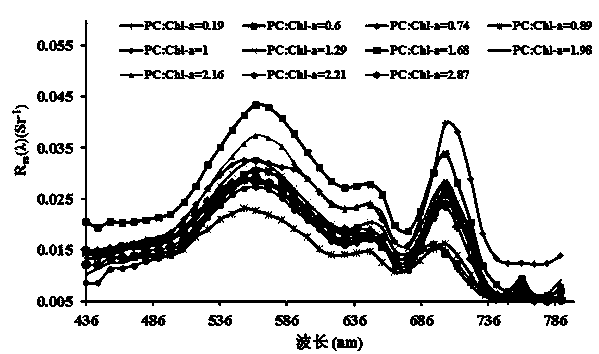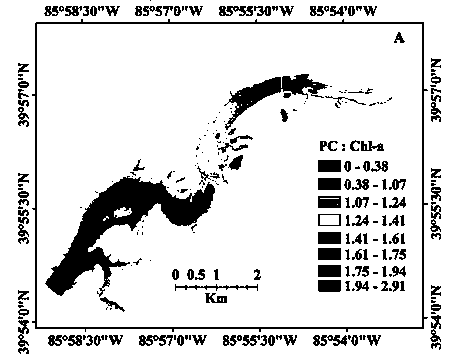Lake water body blue-green algae abundance estimation method based on remote sensing
A technology for lakes and water bodies, applied in the field of remote sensing, can solve the problems of inaccurately reflecting the content of cyanobacteria, and achieve the effect of simple method and high precision
- Summary
- Abstract
- Description
- Claims
- Application Information
AI Technical Summary
Problems solved by technology
Method used
Image
Examples
Embodiment 1
[0029] According to the method of the present invention, the remote sensing reflectance of the water body is obtained by using the surface object spectrometer to measure the lake water body on site, and the cyanobacteria abundance of the water body is estimated, and compared with the measured PC:Chl-a value. The measured values of PC:Chl-a are shown in Table 1 below.
[0030] From the remote sensing reflectance spectrum of the water body ( figure 1 ), select the remote sensing reflectance with wavelengths of 550nm and 620nm, and calculate the abundance of cyanobacteria in the water body according to the method of the present invention, the estimated value and the corresponding error are shown in Table 1 below:
[0031] Table 1
[0032] Measured valuePC:Chl-a Estimated PC:Chl-a Relative error absolute error 0.187087 0.248376 0.327595 0.061289 0.246314 0.265974 0.079816 0.01966 0.302637 0.269286 0.1102 0.033351 0.362848 0.302774 0.1...
Embodiment 2
[0038] By adopting the method of the invention, the abundance of cyanobacteria is estimated for a certain reservoir by using aerial hyperspectral image data. Firstly, radiometric calibration and atmospheric correction are performed on the image data to obtain the remote sensing reflectance data; the remote sensing reflectance ( figure 2 ), into the calculation model of cyanobacteria abundance, calculate the cyanobacteria abundance of the water body, and output the spatial distribution map of cyanobacteria abundance ( image 3), the estimated value is compared with the measured PC:Chl-a value, and the result is reasonable. The estimated water body cyanobacteria abundance and corresponding errors are shown in Table 2 below:
[0039] Table 2
[0040] Measured valuePC:Chl-a Calculated value PC:Chl-a Relative error absolute error 0.155388 0.182984 0.177591 0.027596 0.160087 0.264456 0.651956 0.104369 0.24109 0.356432 0.47842 0.115342 0.2...
PUM
 Login to View More
Login to View More Abstract
Description
Claims
Application Information
 Login to View More
Login to View More - R&D
- Intellectual Property
- Life Sciences
- Materials
- Tech Scout
- Unparalleled Data Quality
- Higher Quality Content
- 60% Fewer Hallucinations
Browse by: Latest US Patents, China's latest patents, Technical Efficacy Thesaurus, Application Domain, Technology Topic, Popular Technical Reports.
© 2025 PatSnap. All rights reserved.Legal|Privacy policy|Modern Slavery Act Transparency Statement|Sitemap|About US| Contact US: help@patsnap.com



